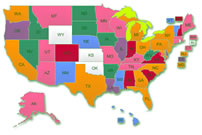 Learning about money doesn’t have to be tedious or dull. Games are a fun, non-threatening way to teach your kids about money, saving, and responsibility. Use the three games below to get you started “playing with money” in your family. Once you have the hang of it, see if your kids can come up with educational money games of their own.
Learning about money doesn’t have to be tedious or dull. Games are a fun, non-threatening way to teach your kids about money, saving, and responsibility. Use the three games below to get you started “playing with money” in your family. Once you have the hang of it, see if your kids can come up with educational money games of their own.
Penny Accumulation Game
Ages 4 and up
To play this game you’ll need a pair of dice and 20 of each type of coin in the game. (For younger children, you may want to start with just two types of coins, such as pennies and nickels, and add dimes and quarters later, when they are better at the game). The object of the game is to be the first player with 50 cents saved. Take turns rolling the dice. Each player gets the amount of pennies shown on the dice-but they have to give back all the pennies in their possession if the dice show a 12. As each player accumulates five pennies or more, the five pennies can be traded in for a nickel and so on. Kids will quickly understand the fact that a dime is worth ten pennies, that a nickel is worth five, and that fewer coins doesn’t necessarily mean less money. Let your child keep the money they win to add to their piggy bank savings.
The Coin ID Game
Ages 5 to 12
In this game, your child is going to gather up a few coins and you are going to magically tell them which coins they have. To start, dump out variety of coins from a coin jar or the bottom of your purse. Ask your child to gather up several coins. Then, ask your child to tell you how much money they have in their hand and how many coins there are. For example, your child could say: “I have 12 cents and 4 coins, what coins could I have in my hand?” You can then guess which coins they have in their hand. (In this case, two nickels and two pennies would be the answer.) Once you get the hang of this and it becomes easy, reverse roles and see if they can tell you which coins are in your hand.
Teen Money Journal
Ages 13 to 18
Teach your teen the importance of keeping good financial records by creating a financial journal together using columnar paper, journal paper, or even a computer spreadsheet. The journal can look like a basic check register, or take any other form that you agree upon. Your teen can note every time she receives money (weekly allowance, part-time job, babysitting), and every time she uses money (for lunch, for clothes, for long-term savings such as college). Once a month, you can review the journal and discuss her money choices. Encourage her to share her journals with her friends, or share your own financial journal with her and discuss your own money questions and answers.






